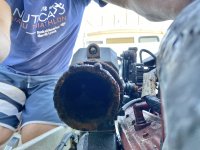Wanted to share a quick update. I finally assembled everything today and did a 30 min test at the boat ramp dock. I ended up doing the exhaust manifolds, the risers, the impeller, the circulation pump, the heat exchanger, and the thermostat. Started it up and quickly found one small leak at the rubber coupler on the exhaust but no other leaks were found. Even with rpm's held at 3000 , I never went above 165. I know I need to do another test under way but so far the temps are down and the risers are cooler than before.
I have a feeling the local boat parts place sold me a 160 thermostat when I told them I have a 1997 Gi-f. This may have caused some confusion. I now have come to learn that I have a 2006 Gi-F motor with a closed cooling system. The manual shows this below.
Thermostat- 5.7Gi-F,5.7GXi-G:66°C(150°F)VolvoPenta PN3587597
Closed Cooling System Thermostat 5.7Gi-FF, 5.7GXi-GF: 77°C (170°F) Volvo Penta PN 3831426. Closed cooling heat exchanger mounted on engine
Any advice on running the 160 or should I install the 170?






















